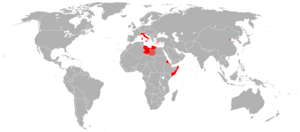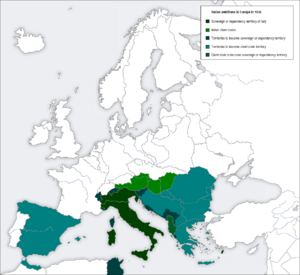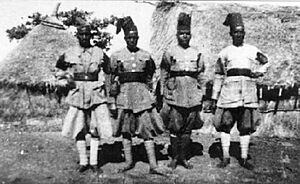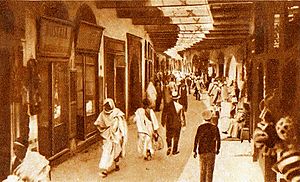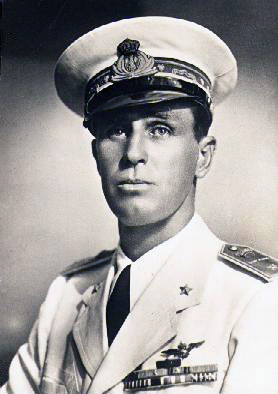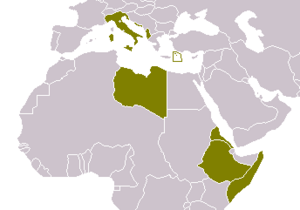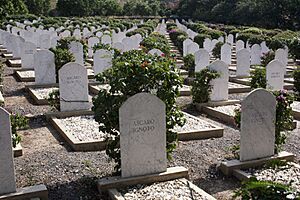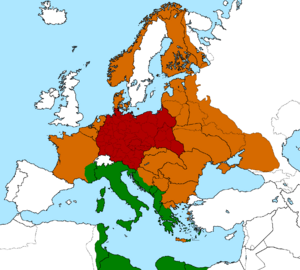Italian Empire facts for kids
Quick facts for kids
Italian Empire
Impero italiano (Italian)
|
|
|---|---|
| 1882–1960 | |
|
|
|
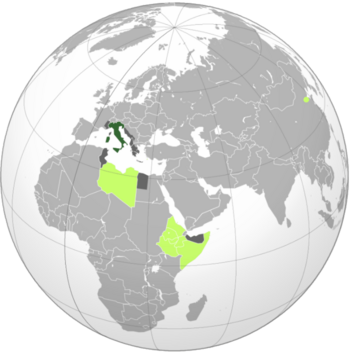
Kingdom of Italy Colonies of Italy Protectorates and areas occupied during World War II
|
|
| Status | Colonial empire |
| King | |
|
• 1869–1878
|
Victor Emmanuel II |
|
• 1878–1900
|
Umberto I |
|
• 1900–1946
|
Victor Emmanuel III |
| History | |
|
• Purchase of Assab
|
1869 |
|
• Italian Eritrea
|
1882 |
|
• Eritrea War
|
1887–1889 |
|
• Italian Somalia
|
1889 |
| 1899–1901 | |
|
• Italo-Turkish War
|
1911–1912 |
|
• Albanian Protectorate
|
1917–1920 |
|
• Pacification of Libya
|
1923–1932 |
| 1935–1937 | |
|
• Albanian Protectorate
|
1939–1943 |
| 1940–1941 | |
| 1940–1943 | |
| 1947 | |
|
• Trust Territory of Somaliland
|
1950–1960 |
| Area | |
|
• Total
|
3,775,294 km2 (1,457,649 sq mi) |
| 1938 | 3,798,000 km2 (1,466,000 sq mi) |
| 1941 | 3,824,879 km2 (1,476,794 sq mi) |
The Italian colonial empire (Italian: Impero coloniale italiano) was a collection of lands controlled by the Kingdom of Italy. It was also known as the Italian Empire (Impero italiano) between 1936 and 1941. This empire started in Africa in the 19th century.
It included colonies, protectorates, and other controlled areas. In Africa, Italy ruled parts of what are now Libya, Eritrea, Somalia, and Ethiopia. These last three were officially called "Africa Orientale Italiana" (AOI). Outside Africa, Italy also controlled the Dodecanese Islands (after a war with Turkey). It also had control over Albania at different times and some special areas in China.
After 1922, the Fascist government, led by Benito Mussolini, wanted to make the Italian empire much bigger. They encouraged many Italians to move to these colonies. By 1939, about 120,000 to 150,000 Italian settlers lived in Italian Libya. Another 165,000 lived in Italian East Africa.
During World War II, Italy joined forces with Nazi Germany in 1940. Italy took over some new lands, including British Somaliland, parts of Egypt, Yugoslavia, Tunisia, France, and Greece. However, by 1943, Italy lost these new lands and its African colonies to the Allied forces. In 1947, Italy officially gave up its claims to all its former colonies. From 1950 to 1960, former Italian Somaliland was managed by Italy under United Nations supervision. It became independent in 1960, marking the end of Italy's colonial empire.
Contents
History of the Italian Empire
Early Beginnings and Roman Influence
The idea of an empire in Italy goes way back to ancient Rome. The Romans called the Mediterranean Sea Mare Nostrum ("Our Sea"). This idea influenced Italian leaders, especially during the Fascist era.
In the Middle Ages, Italian city-states like the Republic of Venice and the Republic of Genoa had their own "colonies" around the Mediterranean. These were known as the Venetian Empire and the Genoese Empire.
From the 15th to 16th centuries, Italian explorers like Cristopher Columbus and Amerigo Vespucci helped other European countries explore the Americas. But Italy itself did not actively join the race to colonize the Americas. This was partly because Italy is in the middle of the Mediterranean Sea, without easy access to the open ocean.
One attempt to create a colony in the Americas was made by Ferdinando I de' Medici, Grand Duke of Tuscany, in 1608. He sent an expedition to explore parts of Brazil. However, the project stopped when he died. Later, in the 17th century, the Knights Hospitaller of Malta, led by an Italian nobleman, controlled four Caribbean islands for a short time. By 1797, Italy had lost its Mediterranean possessions.
The Race for Colonies in Africa
After Italy became a unified nation in the late 1800s, it wanted to compete with other European powers. These powers were expanding their empires around the world. Italy looked to the Mediterranean and the Horn of Africa for new lands.
Italy was a bit late to this "colonial race." It was also not as strong as Britain, France, or Germany. This meant Italy needed their approval to build its empire. Italy had long been interested in Ottoman Tunisia, where many Italians lived. But France took control of Tunisia in 1881. This event, called the "Slap of Tunis" in Italy, made Italy feel isolated. So, Italy joined the Triple Alliance with Germany and Austria-Hungary in 1882.

The Italian colonial empire truly began in 1869. An Italian company bought Assab Bay on the Red Sea to use as a coaling station. The Italian government took over this area in 1882. This became modern Italy's first overseas territory.
Italy continued to seek colonies. In 1886, Italy took control of the port of Massawa in Eritrea from the weakening Egyptian Empire. This cut off the Ethiopian Empire from the sea. At the same time, Italy occupied land in the southern horn of Africa, which became Italian Somaliland.
Italy also wanted to conquer Ethiopia. In 1887, Italian Prime Minister Agostino Depretis ordered an invasion, starting the Eritrea War. This invasion stopped after Italy lost 500 soldiers at the Battle of Dogali.
The next Prime Minister, Francesco Crispi, signed a treaty with the new Ethiopian emperor, Menelik II, in 1889. This treaty gave Italy land around Massawa, forming the colony of Italian Eritrea. The Italian version of the treaty also said Ethiopia was an Italian protectorate. But relations worsened, leading to the First Italo-Ethiopian War in 1895. Italy suffered a major defeat at the Battle of Adwa in 1896. Ethiopia had support from Russian advisors and equipment.
Italy also fought in the Mahdist War in Sudan, winning battles in the 1890s. In 1898, Italy tried to gain a port in China for prestige. China refused, as Italy had little influence there. This led to the fall of the Italian government. However, Italy later joined other European powers in the Boxer Rebellion in China. This resulted in Italy gaining a special area in Tianjin in 1901, which was its only colony in Asia.
A wave of nationalism swept Italy in the early 1900s. People talked about getting revenge for the defeat in Ethiopia and longed for the glory of the Roman Empire. They suggested that Libya, a former Roman colony, should be "taken back." This was seen as a way to solve problems like population growth in Southern Italy.
Fearing that Britain and France would take all of North Africa, Prime Minister Giovanni Giolitti declared war on the Ottoman Empire in October 1911. Libya was part of the Ottoman Empire. As a result of the Italo-Turkish War, Italy gained Libya and the Dodecanese Islands. This war was also important because it saw the first use of armored vehicles and significant air power in warfare.
World War I and Its Effects
In 1914, Italy stayed neutral at the start of World War I. But in 1915, Italy joined the Allies after being promised new territories from Austria and Turkey.
Before joining the war, Italy occupied the Albanian port of Vlorë in December 1914. By 1916, Italy began occupying southern Albania. In June 1917, Italy declared central and southern Albania an Italian protectorate. However, an Albanian rebellion in 1920 forced Italy to return most of these areas to Albania. Only Sazan Island remained under Italian control.
Dalmatia, a region in the Balkans, was also important during World War I. Italy was promised a large part of Dalmatia by the Treaty of London for joining the Allies. By the end of the war in November 1918, Italian forces controlled this promised area.
At the Treaty of Versailles in 1919, Italy received less land in Europe than it expected. It also did not get any overseas mandates, except for a promise of colonial compensation from France and Britain. To fulfill this promise, France and Britain gave Italy several territories between 1919 and 1935. These included lands to expand Libya and Somalia (like Jubaland), the island of Kastellorizo in the Dodecanese, and some areas in Eritrea.
Fascism and the Italian Empire's Growth
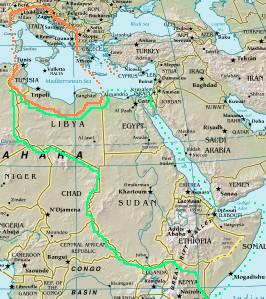
In 1922, Benito Mussolini, the leader of the Italian fascist movement, became Prime Minister and dictator of Italy. Mussolini wanted Italy to be the most powerful country in the Mediterranean Sea. He also wanted Italy to have access to the Atlantic and Indian Oceans.
Mussolini believed that Italy was a "prisoner in the Mediterranean" because it needed permission from France and Britain to access the open seas. He stated that Italy's goal was to "break the bars of this prison." These "bars" included places like Corsica, Tunisia, Malta, and Cyprus.
In the Balkans, the Fascist government wanted to take over Dalmatia and Albania. They also had plans for Slovenia, Croatia, Bosnia and Herzegovina, Vardar Macedonia, and Greece. They wanted to make these areas part of Italy or turn them into Italian-controlled states.
In 1935, Italy launched its second invasion of Ethiopia. This time, Italy was successful. It combined Ethiopia with its older East African colonies to create Italian East Africa (Italian: Africa Orientale Italiana). On May 9, 1936, Mussolini announced the creation of the Italian Empire in East Africa. King Victor Emmanuel III was named Emperor of Ethiopia.
In 1939, Italy invaded and captured Albania. It became a protectorate and a separate kingdom under the Italian crown. King Victor Emmanuel III also became the King of Albania.
The Second Italo-Ethiopian War was costly. About 4,359 Italian and colonial soldiers died. Ethiopian military and civilian deaths were much higher, estimated at up to 275,000, partly due to Italian bombs and mustard gas attacks.
In 1936, Italy also supported Francisco Franco in the Spanish Civil War. Italy hoped to gain control of the Balearic Islands and create a friendly state in Spain. However, Franco did not allow Italy to occupy the islands after the war.
In 1938, Italy demanded more control in the Mediterranean from France. This included areas like Djibouti, Tunisia, and the Suez Canal. Mussolini believed Italy needed a continuous colonial area in Africa, stretching from the Atlantic to the Indian Oceans. He also wanted ten million Italians to settle in these new lands.
World War II and the Empire's End
Mussolini joined World War II in June 1940, siding with Adolf Hitler. He planned to expand Italy's territory even more. He wanted parts of Yugoslavia, southern France, Corsica, Malta, Tunisia, Algeria, and British-controlled Egypt and Sudan.
On June 10, 1940, Italy declared war on Britain and France. In October 1940, Mussolini ordered the invasion of Greece from Albania, but it failed. In April 1941, Germany invaded Yugoslavia and Greece. Italy supported these actions. German and Italian armies quickly took over Yugoslavia and Greece. Italy gained control over parts of both occupied Yugoslavia and occupied Greece.
During the Battle of Britain, Italy also launched an invasion of Egypt to try and capture the Suez Canal. They advanced into Egypt, but in December, the British counter-attacked. By February 1941, the British had defeated the Italian 10th Army and pushed deep into Libya. A German intervention prevented Libya from falling completely. However, by May 1943, Axis forces in Tunisia were forced to surrender.
The East African Campaign began with Italian advances into British-held Kenya, British Somaliland, and Sudan. In the summer of 1940, Italy successfully invaded all of British Somaliland. But in the spring of 1941, the British counter-attacked and pushed deep into Italian East Africa. By May 5, Haile Selassie I of Ethiopia returned to Addis Ababa to reclaim his throne. The last organized Italian resistance ended in November with the fall of Gondar. However, some Italian soldiers continued a guerrilla war for two more years.
In November 1942, when Germany occupied Vichy France, Italy's occupied area in France expanded to include Corsica.
The End of the Empire
By the autumn of 1943, the Italian Empire effectively ended. After many Italian defeats, King Victor Emmanuel III planned to remove Mussolini. Following the Invasion of Sicily, support for Mussolini disappeared. On July 24, the Grand Council of Fascism voted against Mussolini. The next day, Mussolini was removed from power and arrested by the King.
After July 25, the new Italian government, led by the King and Field Marshal Pietro Badoglio, secretly began talks with the Allies. On September 8, the Italian government publicly announced an armistice with the Allies. In Albania, Yugoslavia, the Dodecanese, and other Italian-held territories, German forces attacked their former Italian allies and ended Italy's rule. In China, the Imperial Japanese Army occupied Italy's concession in Tianjin.
In 1947, the Treaty of Peace with Italy officially ended the Italian Empire. There were talks about keeping Tripolitania (a part of Italian Libya) as Italy's last colony, but this did not happen. In November 1949, former Italian Somaliland, which was under British control, became a United Nations Trust Territory managed by Italy for 10 years. On July 1, 1960, Somalia became independent. This marked the final end of Italy's colonial history, which had lasted for about eight decades.
Former Colonies and Occupied Areas
- Italian Eritrea (1882–1947)
- Italian Somalia (1889–1947)
- Trust Territory of Somaliland (1950–1960)
- Libya (1911–1947)
- Italian Tripolitania and Italian Cyrenaica (1911–1934)
- Italian Libya (1934–1943)
- Italian East Africa (1936–1941)
- Italian Ethiopia (1936–1941)
- Italian concessions in China
- Italian concession of Tientsin (1901–1943)
- Italian Albania (1917–1920, 1939–1943)
- Italian Islands of the Aegean (1912–1947)
- Italian occupation of France (1940–1943)
- Italian occupation of Corsica (1942-1943)
- Independent State of Croatia (1941–1945)
- Italian occupation of Montenegro (1941–1943)
- Hellenic State (1941–1943)
- Tunisia (1942–1943)






